
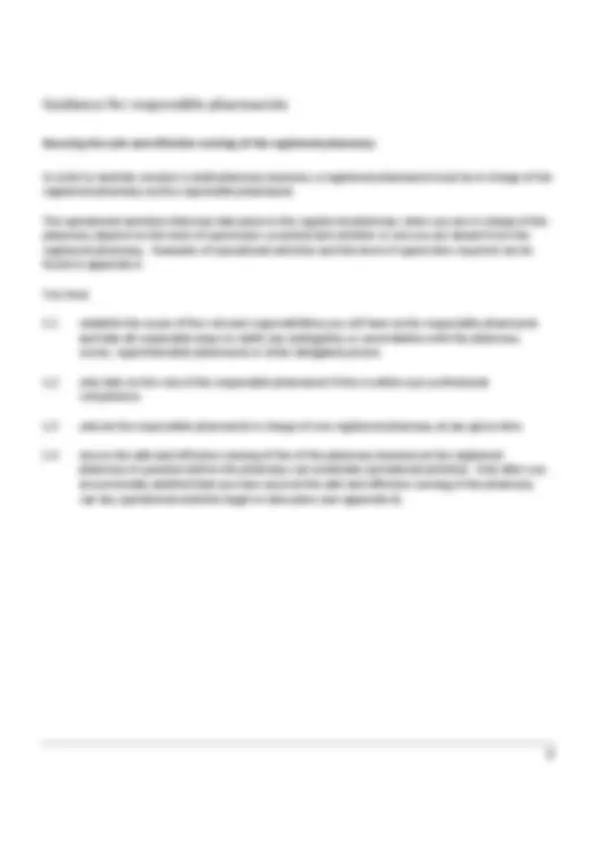

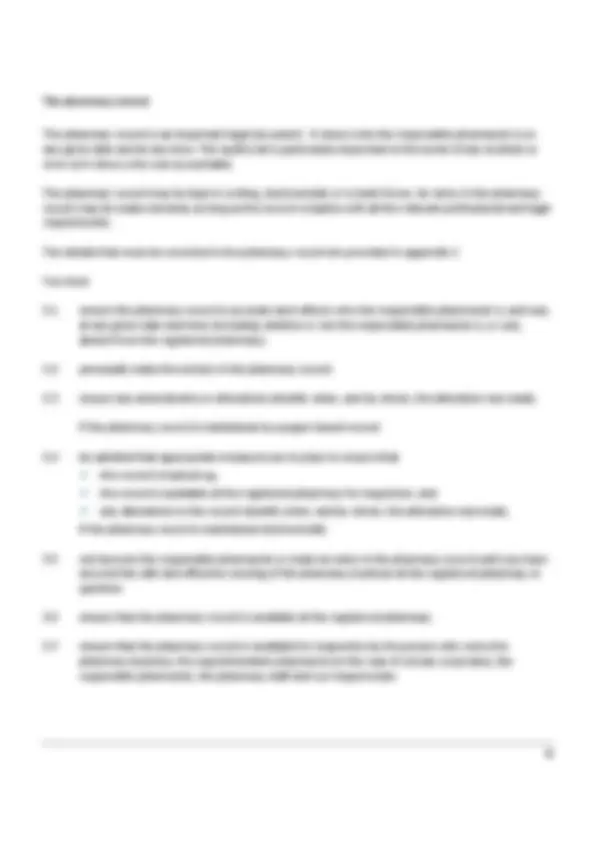
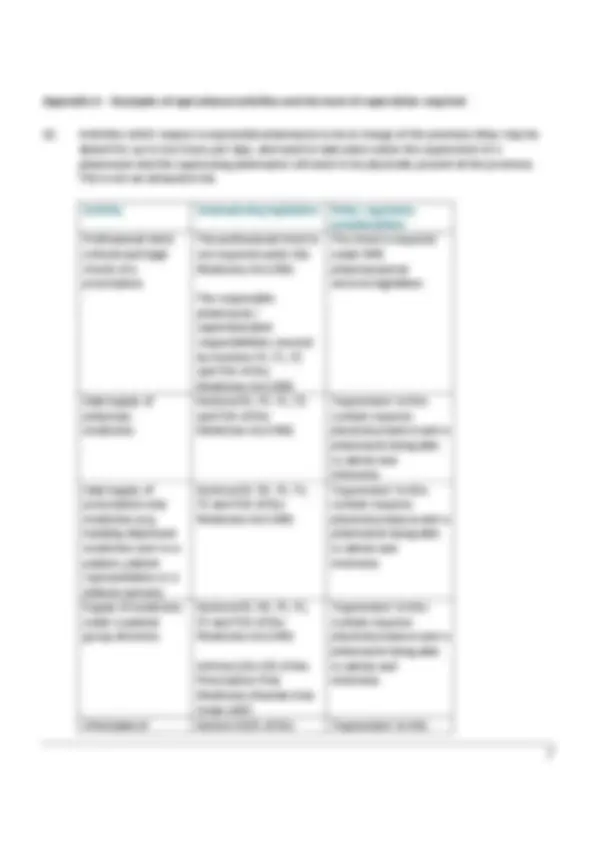
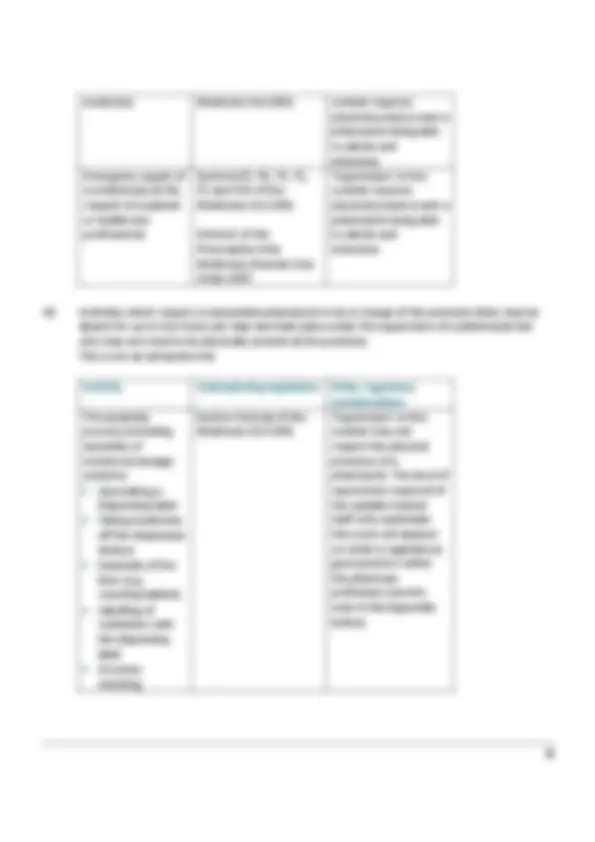
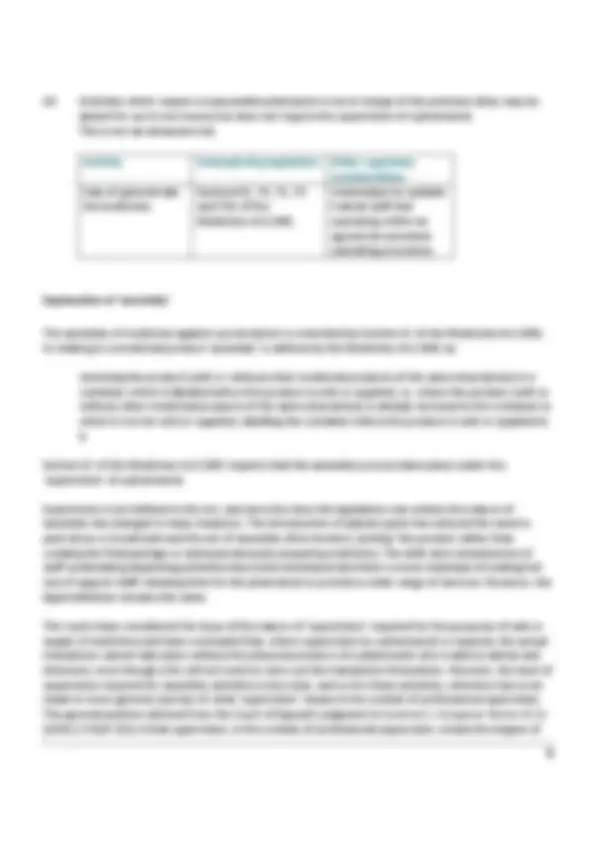
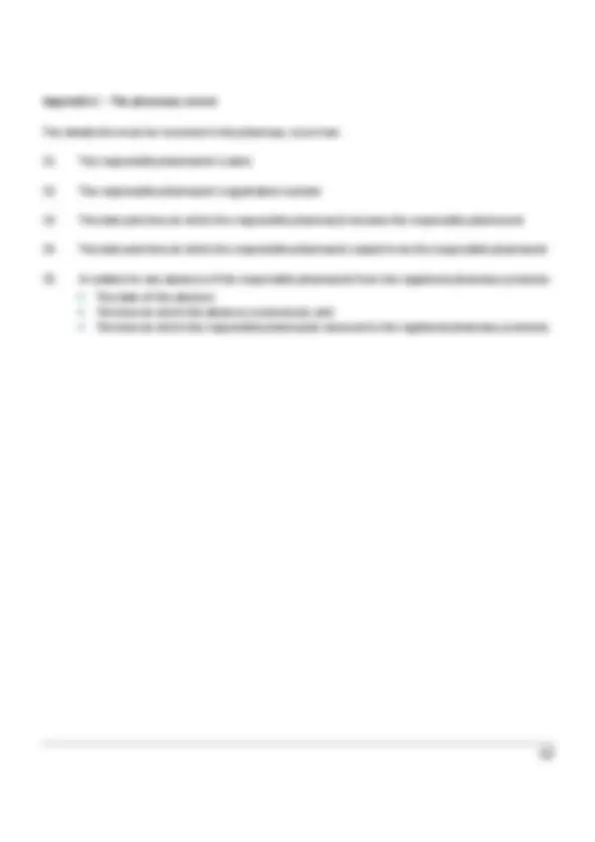
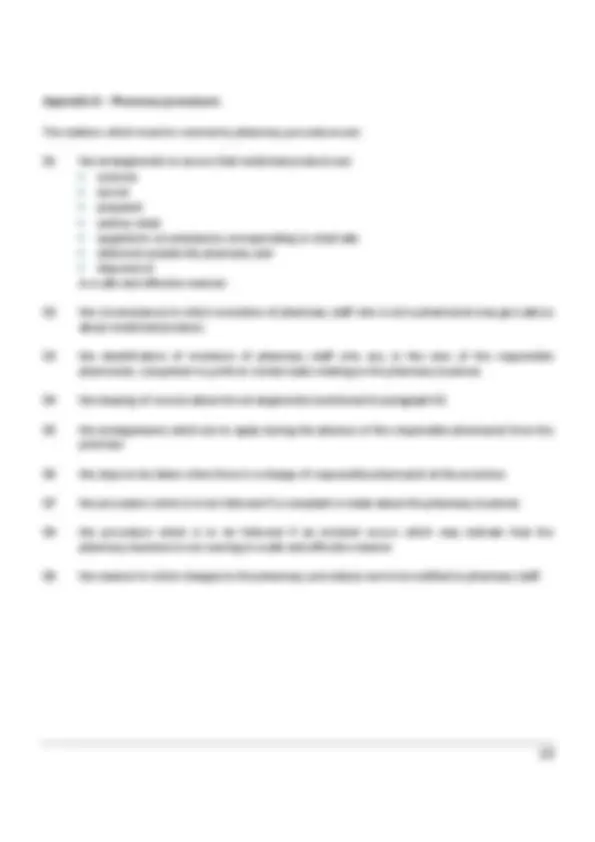


Study with the several resources on Docsity

Earn points by helping other students or get them with a premium plan


Prepare for your exams
Study with the several resources on Docsity

Earn points to download
Earn points by helping other students or get them with a premium plan
Community
Ask the community for help and clear up your study doubts
Discover the best universities in your country according to Docsity users
Free resources
Download our free guides on studying techniques, anxiety management strategies, and thesis advice from Docsity tutors
Guidance for pharmacists on their role and responsibilities as the responsible pharmacist in charge of a registered pharmacy, including securing the safe and effective running of the business, maintaining accurate records, and establishing and reviewing pharmacy procedures.
Typology: Summaries
1 / 14

This page cannot be seen from the preview
Don't miss anything!









Guidance for Responsible Pharmacists
About this guidance
This document provides guidance on standard 7.7 of the standards of conduct, ethics and performance
which states
You must make sure that you keep to your legal and professional responsibilities and that your workload or working conditions do not present a risk to patient care or public safety.
Status of this guidance
This document gives guidance to pharmacists on what they need to do if they are going to take on the role as the responsible pharmacist in charge of a registered pharmacy.
This document does not give legal advice and you must ensure that you comply with the relevant legislative requirements set out in
Displaying the notice
The notice is important as it allows patients and the public to identify the pharmacist who is responsible for the safe and effective running of the registered pharmacy.
The details of the information that must be included on the notice can be found in Appendix B.
You must
2.1 conspicuously display a notice in the registered pharmacy.
The pharmacy record
The pharmacy record is an important legal document. It shows who the responsible pharmacist is on any given date and at any time. This audit trail is particularly important in the event of any incident or error as it shows who was accountable.
The pharmacy record may be kept in writing, electronically or in both forms. An entry in the pharmacy record may be made remotely as long as the record complies with all the relevant professional and legal requirements.
The details that must be recorded in the pharmacy record are provided in appendix C.
You must
3.1 ensure the pharmacy record is accurate and reflects who the responsible pharmacist is, and was, at any given date and time (including whether or not the responsible pharmacist is, or was, absent from the registered pharmacy).
3.2 personally make the entries in the pharmacy record.
3.3 ensure any amendments or alterations identify when, and by whom, the alteration was made,
if the pharmacy record is maintained as a paper-based record.
3.4 be satisfied that appropriate measures are in place to ensure that
3.5 not become the responsible pharmacist or make an entry in the pharmacy record until you have secured the safe and effective running of the pharmacy business at the registered pharmacy in question.
3.6 ensure that the pharmacy record is available at the registered pharmacy.
3.7 ensure that the pharmacy record is available for inspection by the person who owns the pharmacy business, the superintendent pharmacist (in the case of a body corporate), the responsible pharmacist, the pharmacy staff and our Inspectorate.
Absence
The responsible pharmacist may be absent for up to a maximum period of two hours during the pharmacy’s business hours between midnight and midnight. If there is more than one responsible pharmacist in charge of the registered pharmacy during the pharmacy’s business hours, the total period of absence for all the responsible pharmacists concerned must not exceed two hours.
Only certain operational activities (see appendix A) may be undertaken in the pharmacy if the responsible pharmacist in charge of the registered pharmacy is absent.
If you are absent you must:
5.1 remain contactable with the pharmacy staff where this is reasonably practical and be able to return with reasonable promptness, where in your opinion this is necessary to secure the safe and effective running of the pharmacy.
5.2 arrange for another pharmacist to be available and contactable to provide advice to your pharmacy staff for any period of absence where it is not reasonably practicable to remain contactable and return with reasonable promptness.
Appendix A – Examples of operational activities and the level of supervision required
A1 Activities which require a responsible pharmacist to be in charge of the premises (they may be absent for up to two hours per day), and need to take place under the supervision of a pharmacist and the supervising pharmacist will need to be physically present at the premises. This is not an exhaustive list.
Activity Underpinning legislation Other regulatory considerations Professional check (clinical and legal check) of a prescription.
The professional check is not required under the Medicines Act 1968.
The responsible pharmacist / superintendent responsibilities covered by Sections 70, 71, 72 and 72A of the Medicines Act 1968.
The check is required under NHS pharmaceutical services legislation
Sale/supply of pharmacy medicines.
Sections 52, 70, 71, 72 and 72A of the Medicines Act 1968.
‘Supervision’ in this context requires physical presence and a pharmacist being able to advise and intervene. Sale/supply of prescription-only medicines (e.g. handing dispensed medicines over to a patient, patient representative or a delivery person).
Sections 52, 58, 70, 71, 72 and 72A of the Medicines Act 1968.
‘Supervision’ in this context requires physical presence and a pharmacist being able to advise and intervene.
Supply of medicines under a patient group direction.
Sections 52, 58, 70, 71, 72 and 72A of the Medicines Act 1968.
Articles 12A-12E of the Prescription Only Medicines (Human Use) Order 1997.
‘Supervision’ in this context requires physical presence and a pharmacist being able to advise and intervene.
Wholesale of Section 10(7) of the ‘Supervision’ in this
A3 Activities which require a responsible pharmacist to be in charge of the premises (they may be absent for up to two hours) but does not require the supervision of a pharmacist. This is not an exhaustive list.
Activity Underpinning legislation Other regulatory considerations Sale of general-sale list medicines.
Sections 51, 70, 71, 72 and 72A of the Medicines Act 1968.
Undertaken by suitable trained staff and operating within an agreed documented operating procedure.
Explanation of ‘assembly’
The assembly of medicines against a prescription is controlled by Section 10 of the Medicines Act 1968. In relating to a medicinal product ‘assembly’ is defined by the Medicines Act 1968 as:
enclosing the product (with or without other medicinal products of the same description) in a container which is labelled before the product is sold or supplied, or, where the product (with or without other medicinal products of the same description) is already enclosed in the container in which it is to be sold or supplied, labelling the container before the product is sold or supplied in it.
Section 10 of the Medicines Act 1968 requires that the assembly process takes place under the ‘supervision’ of a pharmacist.
Supervision is not defined in the Act, and since the time the legislation was written the nature of assembly has changed in many instances. The introduction of patient packs has reduced the need to pack down or break bulk and the act of assembly often involves ‘picking’ the product rather than creating the final package or extemporaneously preparing medicines. The skills and competencies of staff undertaking dispensing activities have been developed and there is more emphasis of making full use of support staff releasing time for the pharmacist to provide a wider range of services. However, the legal definition remains the same.
The courts have considered the issue of the nature of ‘supervision’ required for the purposes of sale or supply of medicines and have concluded that, where supervision by a pharmacist is required, the actual transaction cannot take place without the physical presence of a pharmacist who is able to advise and intervene, even though s/he will not need to carry out the transaction themselves. However, the level of supervision required for assembly activities is less clear, and so for these activities, reference has to be made to more general case law of what ‘supervision’ means in the context of professional supervision. The general position (derived from the Court of Appeal’s judgment in Summers v Congreve Horner & Co [1992] 2 EGLR 152) is that supervision, in the context of professional supervision, means the degree of
supervision required by what is regarded as good practice within the profession, having regard to the qualifications and experience of the person being supervised, but actual physical presence may not be necessary.
Applying that to the present context, it means that if the pharmacist responsible for supervising assembly of a medicinal product is absent, pharmacy support staff may continue to carry out activities which are considered to be “assembling” activities for the purposes of the definition set out above, without breaching the legislation, provided it is recognised good practice within the pharmacy profession that they be allowed to do so. The Royal Pharmaceutical Society publishes good practice guidance, but it is important to emphasise that no single solution fits all circumstances. What may be good practice for one type of assembling activity may not be good practice for other types of assembling activities, and all such activities must be ”supervised” at an appropriate level.
It is also important to emphasise that this does not affect the position that the supply of assembled medicines against a prescription is prohibited unless the pharmacist is physically present in the registered pharmacy and in a position to advise and intervene. However, ‘supervision’ is not a ‘one size fits all circumstances’ legal concept, and the courts have recognised this.
Appendix C – The pharmacy record
The details the must be recorded in the pharmacy record are
C1 The responsible pharmacist’s name
C2 The responsible pharmacist’s registration number
C3 The date and time at which the responsible pharmacist became the responsible pharmacist
C4 The date and time at which the responsible pharmacist ceased to be the responsible pharmacist
C5 In relation to any absence of the responsible pharmacist from the registered pharmacy premises
Appendix D – Pharmacy procedures
The matters which must be covered by pharmacy procedures are
D1 the arrangements to secure that medicinal products are
D2 the circumstances in which a member of pharmacy staff who is not a pharmacist may give advice about medicinal products
D3 the identification of members of pharmacy staff who are, in the view of the responsible pharmacist, competent to perform certain tasks relating to the pharmacy business
D4 the keeping of records about the arrangements mentioned in paragraph D
D5 the arrangements which are to apply during the absence of the responsible pharmacist from the premises
D6 the steps to be taken when there is a change of responsible pharmacist at the premises
D7 the procedure which is to be followed if a complaint is made about the pharmacy business
D8 the procedure which is to be followed if an incident occurs which may indicate that the pharmacy business is not running in a safe and effective manner
D9 the manner in which changes to the pharmacy procedures are to be notified to pharmacy staff.